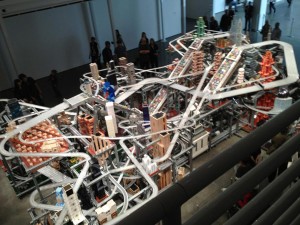Finding USC at LACMA
From an aerial view, Los Angeles looks like a never-ending series of packed neighborhoods and congested roads.
For new students about to touch down in the City of Angels, that might be a little overwhelming. Just how bad is bad traffic? How many people does one have to push through to get around on the streets?

Tangles and traffic · The many roads of Los Angeles — and life — are reflected in Chris Burden’s “Metropolis II,” at LACMA. Viewers make use of the room’s different angles and areas to find their own unique perspective. – Eva Recinos | Daily Trojan
Inside the Los Angeles County Museum of Art, the idea of the hustle and bustle of the city comes to life through Chris Burden’s “Metropolis II,” a huge recreation of the busy atmosphere that comes with any large city.
Made of steel beams, the installation perfectly captures the city’s chaos — there are roughly 100,000 toy cars buzzing throughout a complex track that includes a six-lane freeway. As visitors walk around the entire work, they can spot carefully constructed buildings with a complex track woven through for the many speeding toy cars. It possesses the most obvious facets of a sprawling city — loud, seemingly endless traffic and buildings upon buildings.
During most hours, the creation lies dormant and viewers can follow the complex weavings of the track and admire the intricate architecture of the buildings sans the recreated city noise. But during weekend hours at the museum, the sculpture comes to life as the cars start racing throughout their given pathways in a rainbow flurry of movement.
Viewers can walk around the piece or venture upstairs to view it from afar; either view creates the same sense of a constant energy and flow. Visitors of all ages gather round the work and snap photos, laugh at one movement or another, study a building that just came into their line of vision or simply stand back to take in the exhibit as a whole.
The person in charge of starting the cars and maintaining the flow of movement stands inside, sans shoes, equipped with earplugs. In many ways, then, the sculpture becomes an experience, not just a work of art.
“Metropolis II” can be seen multiple times without getting boring — you can stand in a different area, tilt your head for a different angle and exchange the excitement of seeing it for the first time for a newfound appreciation from a second view.
Likewise, USC might look the same to newcomers and those returning, but to each person it will be the stepping stone to something completely different. From the outside, campus might look buzzing to the brim and filled beyond capacity, but that’s no reason to search for a pair of earplugs and wait for it to settle down — instead, the bustle should serve as inspiration for taking your experience in full swing, making of it whatever you will.
What’s consistent in Burden’s work is the emotional exhilaration. The work might seem stressful, intriguing, exciting or fearful to different visitors. Because of the wide range of reactions, the smaller parts of the “Metropolis II” become parts of a greater whole — the experience itself.
In a similar way, the students, buildings and noises of campus become part of the greater adventures that new students experience when they come to campus this fall semester.
Does the experience then become overwhelming and frightening? It’s all in the eye of the beholder. Surely some visitors will leave LACMA with a near headache while others will be simply amused. Yet both types of visitors will get into their cars and head back to the real metropolis awaiting them outside. No experience will be the same for two students, even when all the same factors make up their first day.
Just as visitors gaze on the mechanical makeup of the work — the architectural character of the buildings, the swerves in the freeway track, the colors of the toy cars — new students will take in USC’s exterior. Eventually, they will discover even its most hidden gems and learn just how loud campus gets during peak hours. But the buildings and people ultimately make up one experience that will differ from person to person. “Metropolis II,” as does campus, only gets so busy during a certain time period — but the overall experience lasts much longer. It’s ultimately up to the viewer whether the work makes a positive mark on them, just as the students must decide exactly what they will do with all the elements of the campus experience.
Burden’s work crafts a relatively small space into an idea far too large to fit inside one room. The best thing a viewer can take away from the piece is the idea that perhaps sometimes we get too trapped in all the movement of a metropolis. It’s a fragment of a huge world, an environment filled with possibilities.
In the same way, USC’s campus is ultimately part of a greater whole —the future that students craft when they leave its grounds.
